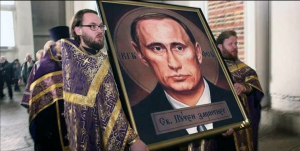The Ukrainians sank the “Moskva,” the cruiser-flagship of the Russian Black Sea Fleet, the same ship that the border guards had ordered “na хуй” at the beginning of the war and whose firepower was equal to that of an armored division. The ship caught fire and sank with all its missiles and probably with the religious relic it contained, a splinter of wood only a few millimeters long, said to have come from the cross on which Christ was struck. A disaster not only in military terms, but also in symbolic terms. For the Kremlin residents take the mystical very seriously; in this respect, too, they are trying to emulate the German Nazis, except that instead of the Ahnenerbe organization they have the Russian Orthodox Church or the Moscow Patriarchate, whose obsession with the idea of “Moscow as a third Rome” has led them to practice the tradition of blessing weapons, including such instruments of mass destruction as the “Satan” intercontinental ballistic missile system. But if the mysticism of Christianity disappoints them, support can be found in pagan rituals, which are also not foreign to the Kremlin. There is talk of sacrificial ceremonies in the Siberian taiga or in the Ural mountains, in which the Kremlin leadership also participates. The life of a heraldic animal such as a bear, eagle, wolf or deer is sacrificed to the gods, and with its blood the participants are energized and sacralized, while Putin, in order to stay young, took a bath in the blood of the horns of young marals. In parallel, there is a Yakut shaman, Alexander Gabishev, who organized a collective march to Moscow in 2019 to light fires in Red Square and expel the demon Putin from the Kremlin, but he never reached the capital because those in power must not allow it after all. Conclusion: The threat posed by the shaman is taken seriously in the Kremlin, which is why the tactic of forced incarceration is used; he is declared sick and isolated in a psychiatric hospital. As far as is known, he is still there, gathering forces to the detriment of the government. Meanwhile, the sunken ship begins to pull many people from Moscow itself in darkness, because there are already arrests and suspicious diseases. It is feared that Putin wants to take revenge on Ukrainians by bombing a sacred site such as St. Sophia Cathedral in Kiev, which has been there since the first half of the 11th century, a time when there was no Moscow. It is risky, though; perhaps someone will remind him that Moscow was founded by the Grand Duke of Kiev, Yuri Dolgoruki, and if you believe in mystical connections, you never know if Moscow itself would not suffer.
The main cathedral of the Russian army, opened 2 years ago – https://hram.mil.ru/
Ukraiņi nogremdēja Krievijas Melnās jūras kara flotes flagmani kreiseri “Moskva”, to pašu, ko kara sākumā robežsargi pasūtīja “на хуй” un kas uguns jaudas ziņā bija līdzvērtīgs tanku divīzijai. Kuģis aizdegās un nogrima ar visām raķetēm, un droši vien kopā ar reliģisko relikviju, kas tur glabājās – dažus milimetrus garo koka skaidu, kas it kā esot no krusta, pie kura sita Kristu. Katastrofa ne tikai militārajā ziņā, bet arī simboliskā nozīmē. Jо Kremļa iemītnieki mistisko uztver ļoti nopietni, arī šajā ziņā viņi mēģina atdarināt vācu nacistus, tikai organizācijas Ancestral Heritage vietā viņiem ir Krievu Pareizticīgā baznīca jeb Maskavas patriarhāts, kā apsēstība ar ideju “Maskava – trešā Roma” ir likusi piekopt tradīciju svētīt ieročus, arī tādus masu iznīcināšanas rīkus kā starpkontinentālo ballistisko raķešu sistēmu “Sātans”. Bet, ja pieviļ kristietības mistika, tad var mēģināt rast atbalstu pagāniskajos rituālos, arī tie Kremlim nav sveši. Klejo runas par Sibīrijas taigā vai Urālu kalnos piekoptajām upurēšanas ceremonijām, kurā piedalās pati Kremļa spice. Dieviem upurē kāda heraldiskā dzīvnieka, piemēram, lāča, ērgļa, vilka vai brieža, dzīvību un ar tā asinīm enerģizē, sakralizē dalībniekus, bet, lai saglabātu jaunību, Putins mēdzot gremdēties vannās, kas pildītas ar asinīm no jauno marālu ragiem. Paralēli eksistē jakutu šamanis Aleksandrs Gabiševs, kurš 2019. gadā organizēja kolektīvu gājienu uz Maskavu, lai uzkurtu Sarkanajā laukumā sārtu un izdzītu dēmonu Putinu no Kremļa, taču galvaspilsētu viņš tā arī nav sasniedzis, jo vara nedrīkst to pieļaut. Jāsecina, ka šamaņa draudus Kremlī uztver nopietni, tāpēc pielieto piespiedu hospitalizācijas taktiku, pasludina par slimu un izolē psihiatriskajā klīnikā. Cik zināms, tad viņš tādā atrodas arī šobrīd un, varai par skādi, akumulē spēkus. Tikmēr nogremdētais kuģis sāk raut sev līdzi tumsā daudzus no pašas Maskavas, jau notiek aresti un aizdomīgas saslimšanas. Pastāv bažas, ka Putins varētu vēlēties atriebties ukraiņiem, sabombardējot kādu sakrālu objektu, piemēram, Kijivas Svētās Sofijas katedrāli, kas tur slejas kopš 11. gadsimta pirmās puses, laika, kad nekādas Maskavas vēl nebija. Tas gan ir riskanti, varbūt viņam kāds atgādinās, ka Maskavu dibināja Kijivas lielkņazs Jurijs Dolgorukijs un, ja tic mistikām sakarībām, tad ej nu zini, vai neciestu pati Maskava.
Pirms 2 gadiem atklātā galvenā Krievijas Armijas katedrāle – https://hram.mil.ru/


